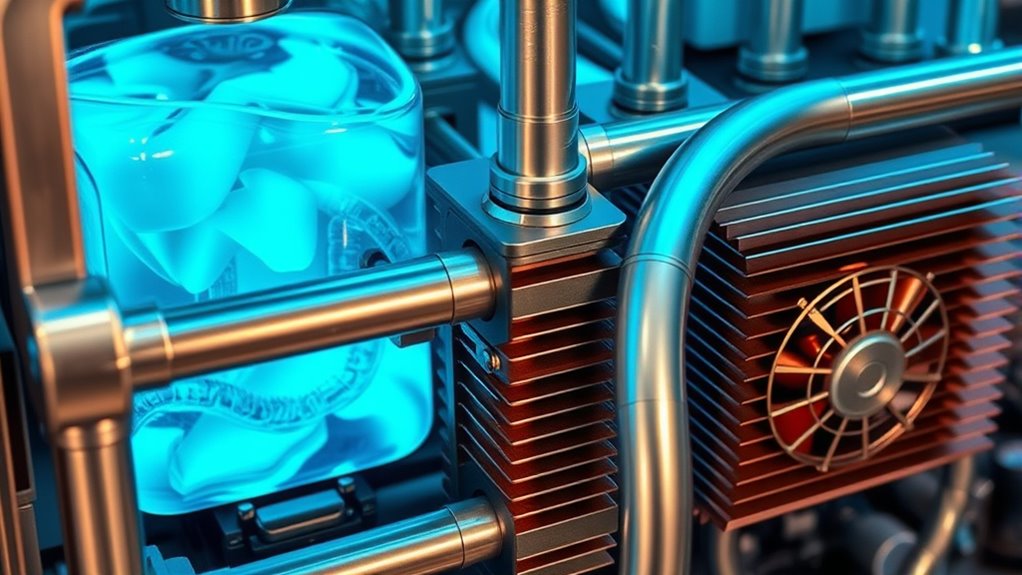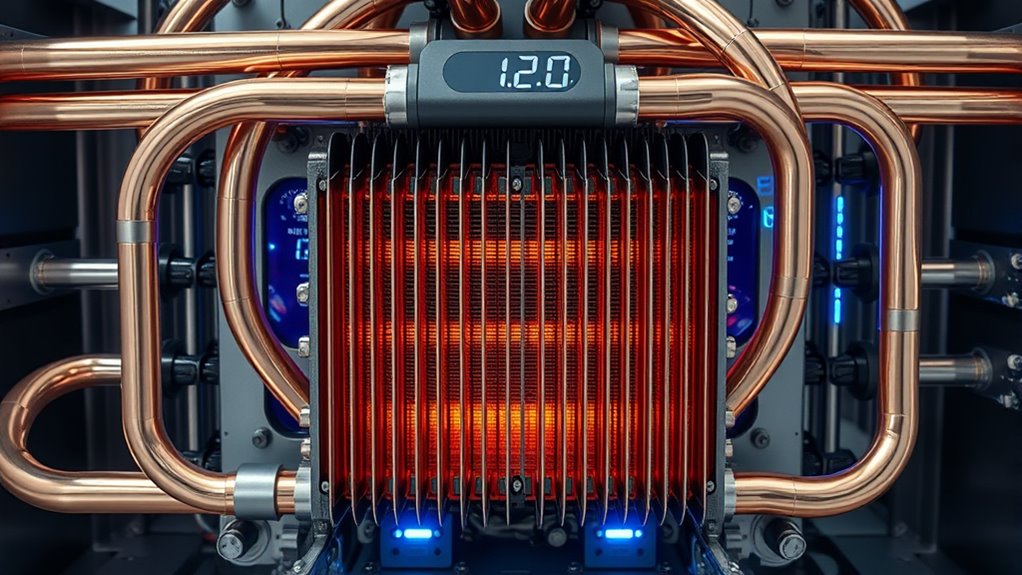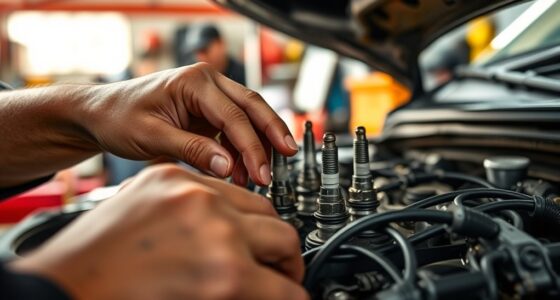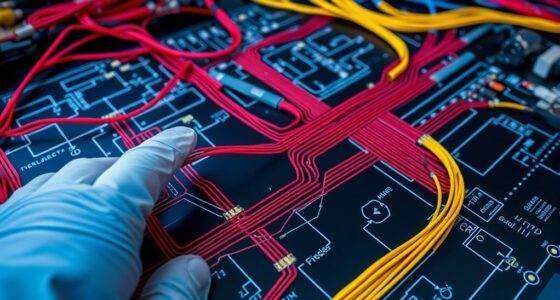A cooling system helps manage heat generated by engines or electronics by transferring it to the air through components like radiators with fins and tubes made of aluminum or copper. Coolants, often glycol-based, absorb heat and circulate to prevent overheating. Proper design, material choice, and maintenance guarantee efficient heat dissipation and system longevity. Understanding these elements can help you optimize performance, and exploring further reveals how each part works together to keep everything running smoothly.
Key Takeaways
- Radiators dissipate heat from coolant to the surrounding air using fins and tubes made of high thermal conductivity materials.
- Heat transfer in cooling systems occurs through conduction, convection, and sometimes phase change mechanisms.
- Coolants, often glycol-based, absorb heat from engines or devices, preventing overheating and maintaining optimal operating temperatures.
- Proper coolant selection, regular maintenance, and system checks are essential for efficiency and preventing corrosion or system failure.
- Well-designed radiators and correct coolant management enhance overall cooling performance and system longevity.

Have you ever wondered how electronic devices and engines stay cool during operation? The answer lies in the cooling systems that prevent overheating and maintain ideal performance. One of the key components in many cooling systems is the radiator, which is designed to dissipate heat efficiently. Radiator design plays a pivotal role in how effectively heat is transferred from the coolant to the surrounding air. Modern radiators often feature a network of thin metal fins and tubes that maximize surface area, allowing heat to escape quickly. The arrangement of these fins and the material used, typically aluminum or copper, greatly influences cooling performance. A well-designed radiator ensures that the coolant flows smoothly through its channels, avoiding hotspots and promoting even heat exchange. Additionally, coolant flow dynamics influence how uniformly heat is distributed and removed from the system.
Alongside radiator design, selecting the right coolant type is essential. Coolants are specially formulated liquids that absorb heat from the engine or device and transfer it to the radiator for dissipation. There are various coolant types, including traditional glycol-based mixtures and newer, more advanced formulations. Glycol-based coolants, commonly used in automotive engines, are effective at lowering freezing points and raising boiling points, making them suitable for a wide range of operating temperatures. Some coolants also contain corrosion inhibitors to protect metal components within the cooling system, extending its lifespan. In electronic devices, specialized coolants like dielectric liquids or phase change materials may be used to guarantee safety and efficiency.
The choice of coolant impacts not only the thermal performance but also the longevity of the entire cooling system. Using the wrong coolant or neglecting regular maintenance can lead to corrosion, buildup, and reduced heat transfer efficiency. Thus, understanding the specific requirements of your device or engine is necessary. Many cooling systems are designed to operate with a specific coolant type, and manufacturers often provide recommendations for ideal performance. Regularly checking coolant levels and replacing old or contaminated fluids help keep the system running smoothly.
Frequently Asked Questions
What Are the Signs of a Failing Cooling System?
If your cooling system is failing, you’ll notice signs like the engine overheating, which indicates radiator efficiency issues. You might also see coolant leaks or smell burning coolant, suggesting a problem. A malfunctioning thermostat can cause inconsistent engine temperatures or overheating. Listen for strange noises or vibrations, and check for dashboard warning lights. Addressing these signs promptly helps preserve radiator efficiency and ensures your thermostat functions correctly.
How Often Should Coolant Be Replaced?
Imagine your engine’s temperature gauge rising like a rising sun—your coolant keeps that in check. You should replace your coolant every 2 to 5 years, depending on your vehicle’s coolant lifespan and its recommended replacement intervals. Regularly checking coolant levels and quality helps prevent overheating. Don’t wait for signs of trouble; proactive coolant changes protect your engine and keep it running smoothly, avoiding costly repairs later.
Can a Cooling System Be Repaired or Replaced?
Yes, your cooling system can be repaired or replaced if it’s nearing the end of its lifespan or showing issues. Repair costs vary depending on the damage, so doing a repair cost analysis helps you decide whether fixing it is worth it or if replacement is more cost-effective. Keep in mind, timely repairs can extend your cooling system’s lifespan, preventing more severe and expensive problems down the line.
What Are the Common Causes of Cooling System Leaks?
You’ll often find cooling system leaks caused by radiator corrosion or hose degradation. Corrosion weakens metal parts, leading to holes and leaks, while hoses deteriorate over time due to heat and wear, causing cracks or splits. Regular inspections help catch these issues early. If you notice coolant loss or puddles under your vehicle, it’s likely due to these common causes. Addressing them promptly keeps your cooling system running smoothly.
How Does Ambient Temperature Affect Cooling System Performance?
Did you know that ambient temperature can increase cooling system efficiency by up to 15% in ideal conditions? You’ll notice that higher ambient impact raises the system’s workload, making temperature regulation more challenging. When outdoor temperatures soar, your cooling system has to work harder to maintain steady internal conditions, which can lead to increased energy use and wear. Conversely, cooler air helps the system operate more efficiently and prolongs its lifespan.
Conclusion
Now that you see how a cooling system acts like a essential heartbeat, keeping your equipment from overheating, you understand its importance. Think of it as a guardian angel, tirelessly working behind the scenes to maintain balance and prevent chaos. Without it, your devices would turn into blazing suns, unstoppable and dangerous. So, remember, a well-maintained cooling system is your silent hero—protecting your technology and ensuring everything runs smoothly, like a well-choreographed dance.









